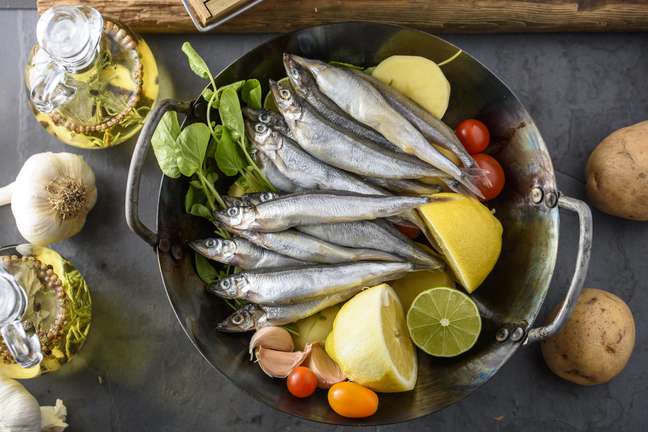Marinated, raw, grilled: there are several preparations that demonstrate the versatility of fish, one of the cheapest on the market
Despite being a figure on the Brazilian table, sardines were far from the restaurant menus. After all, the very low price, the difficulty in beating the fish’s backbone and the strong and characteristic taste, have made the chefs take a step back to work with other fish. But, in recent times, sardines have begun to get noticed by overcoming prejudices and entering the menu.

Today the main preparation of sardines is the most traditional and unlikely possible: grilled, accompanied by cornbread, potatoes and wine. To the Portuguese Ranch, particularly in the restaurant unit on the Avenida dos Bandeirantes, it is thus served on special occasions, at the Sardinha Festival. The house has a large barbecue in the outdoor area, while the customer pays a single price and can eat as much as he wants.
It worked very well: now the festival will take place in two other units of the house, in Mairiporã and in the Castelo Branco restaurant. “In two days of celebration, tons of sardines come out,” says Valdeci Castro, general manager of Rancho Português São Paulo. “It is a cultural habit in Portugal, to put the embers on the street during the sardine fishing season, and serve it like this, whole, with bread and potatoes. Luckily the habit worked in Brazil too”.
Another restaurant that has embraced this habit is Tavern 474, a fish restaurant in Jardim Paulistano. On the menu, the fish is served in this traditional way, directly on the grill. But the house also started experimenting with the dish: raw sardines with parsley and lemon, marinade and a sandwich, served roasted with onions. “What comes out the most are the grilled sardines,” says Luis Felipe Moraes, owner of Taberna 474 and Adega Santiago. “After all, not everyone who loves fish likes sardines.”
Sardine? Yes, sir!
Sardines are also a staple in Japanese cuisine restaurants. The delicacy is already widely used in restaurants in Japan, but it took some time to get the space it deserves in Brazilian homes. Jun Sakamoto is one of the pioneers of omakase in Brazil – a system in which the chef surprises the customer, with varied preparations – and to serve the sardines in his service. No wonder: he says the best sushi he ever ate was sardine sushi, served in the Sukiyabashi Jiro Honten setting.
“There’s still a lot of prejudice against sardines, that’s why it’s so interesting to use them here at omakase. In this system, you eat things you wouldn’t normally order,” explains Jun Sakamoto, behind his counter in Pinheiros. It serves the delicacy marinated and with a pinch of grated ginger. Those who have tasted it say it is an explosion of flavors in the mouth – no wonder, it has already been voted one of the 100 best dishes of the year, according to Paladar.
Jun, however, still sees a lot of prejudice around sardines. In the chef’s reflections, as he prepares the omakase, his eyes sparkle when asked if he would be serving sardines at Junji Sakamoto, the chef’s more casual restaurant in a mall in São Paulo. “No, that’s not good,” he says as he prepares a delicious (and unlikely) eel tempura. “Sardine is coming to a place full of irony. Despite being a very cheap product, it is seen as something sophisticated in restaurants.”
Chef Gérard Barberan, head of the operations of the Japanese restaurant Kuro, knows this: according to him, not everyone wants to leave the house to eat sardines. However, in the restaurant’s omakase, it appears in many forms, from hot dishes, to marinated sardines to versions dipped in soy sauce or marinated in vinegar. “It’s a very versatile, healthy fish with a lot of omega 3s,” he explains. “Our mission is to educate and show good things. If people don’t eat a good plate of sardines in restaurants, they will hardly buy them at the market.”
Cheap and hard to find
Despite this success of sardines, all the chefs say in unison: it’s not that easy to find good sardines on the market. While visiting Jun Sakamoto’s restaurant, the report was unable to taste the delicacy. “It’s really hard to find,” the chef said, right at the start of the service. “Sometimes it comes very, very lean. We have to do all the work to save the fish before we actually put it in the omakase of the day.”
Rancho Português, which imports between 10 and 12 tons of Portuguese sardines a year, needs organization. “Portuguese sardines are not easy, no. Right at the beginning of the year we make a program with the importers we already know, whose origin and quality we know. If we leave it for later, there is no way. , they are already starting to matter for us, “he says.
Barberan says he celebrates when he finds sardines at the market. “It is the cheapest fresh fish in Ceagesp. It costs R $ 6 or R $ 8 per kilo. There is no equal,” he explains. “However, perhaps also because it is such an inexpensive fish, it is difficult to find quality sardines. Some boats work well, others not. The process of something that is cheap gets worse, especially in terms of logistics. Huge evolution, with people realizes that we have wonderful sardines caught here on the Brazilian coast. “
Source: Terra
Benjamin Smith is a fashion journalist and author at Gossipify, known for his coverage of the latest fashion trends and industry insights. He writes about clothing, shoes, accessories, and runway shows, providing in-depth analysis and unique perspectives. He’s respected for his ability to spot emerging designers and trends, and for providing practical fashion advice to readers.








